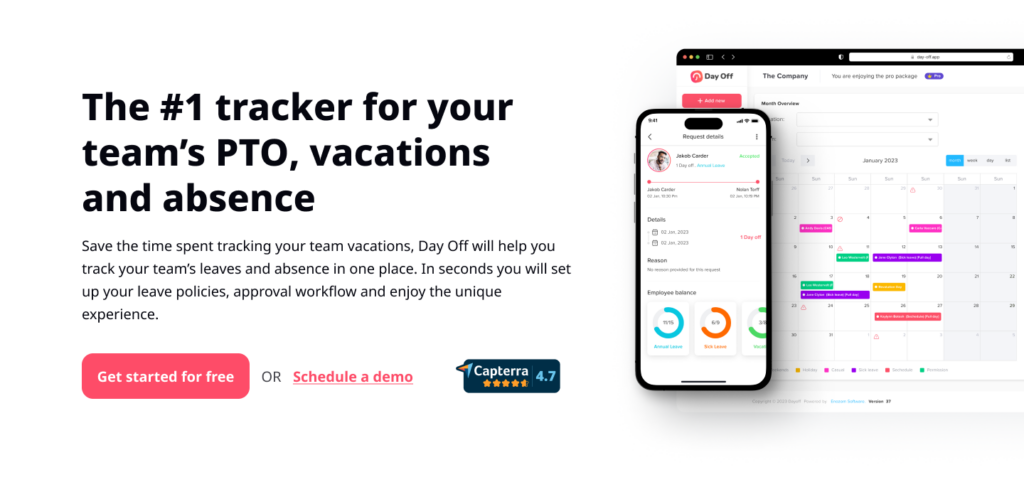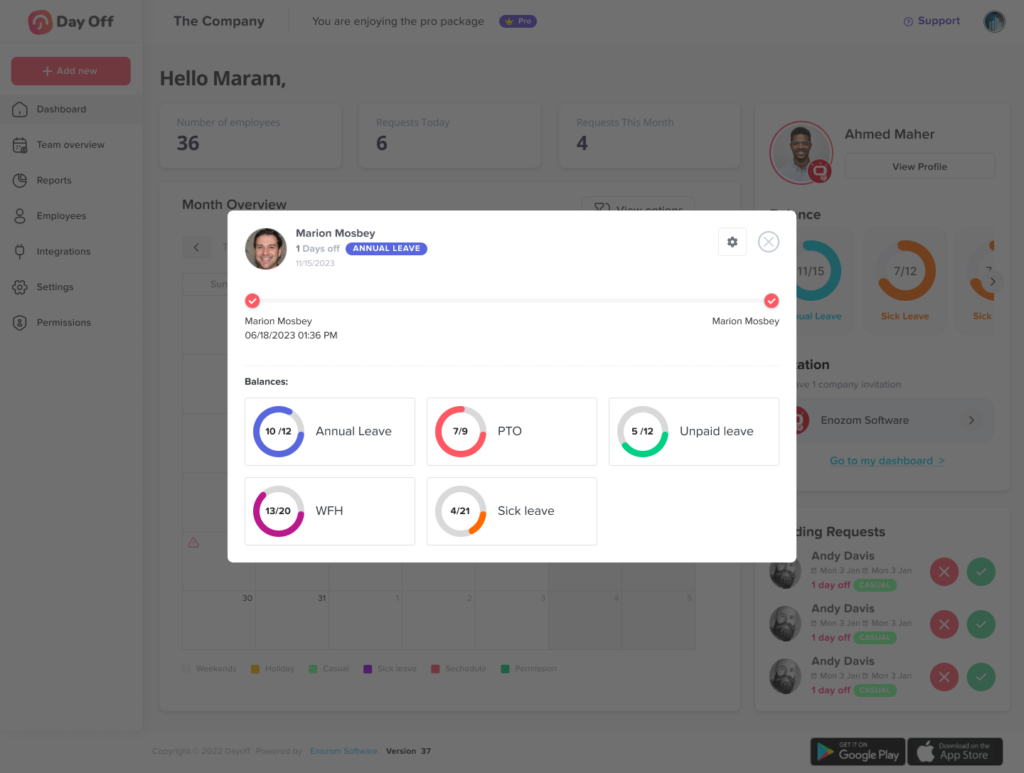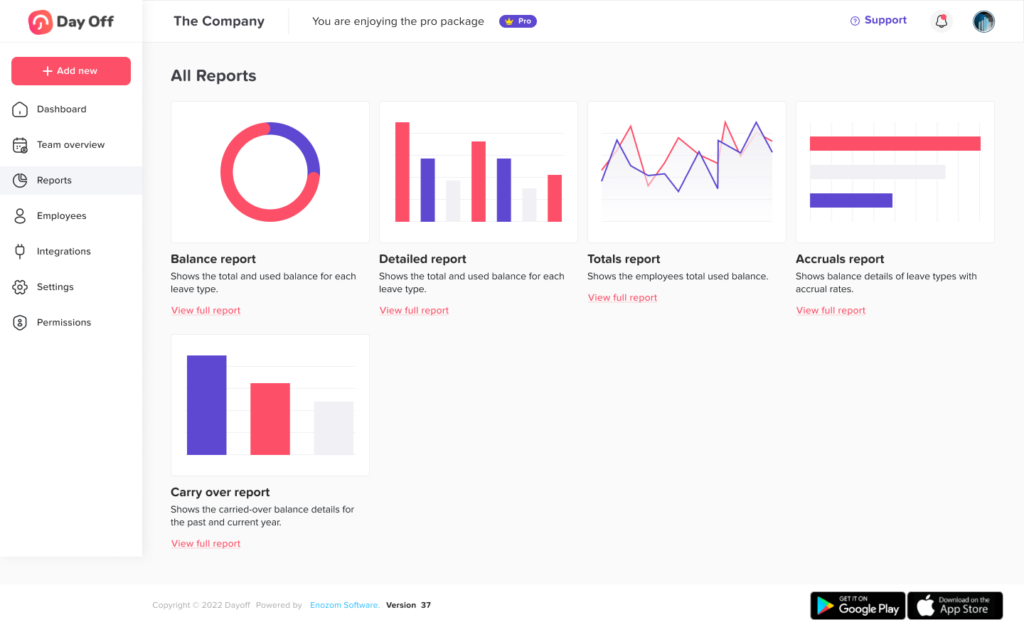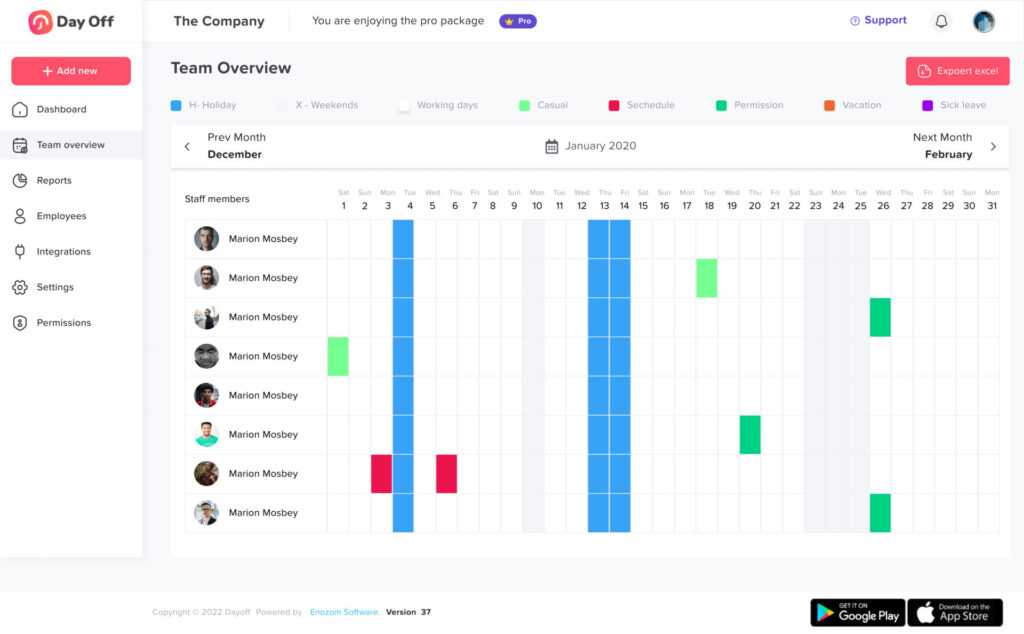Table of Contents
ToggleIt’s important to keep a good balance between work getting done and looking after employee well-being. Managing time off well is key to this balance. Good leave management makes sure work goes smoothly and makes the workplace happier and healthier. We’ll look at simple ways to handle leave that help make a supportive and productive place to work.
Establish Clear Leave Policies
The foundation of effective leave management lies in having clear, transparent, and accessible leave policies. These policies should outline the types of leaves available (such as annual leave, sick leave, parental leave, etc.), the process for applying for leave, and any rules or limitations. Clear policies help avoid misunderstandings and ensure that both employees and managers know what to expect.
Utilize Leave Management Software
Leveraging technology can significantly streamline the leave management process. Leave management software allows employees to request leaves digitally, and managers to approve them, all within a centralized system. This reduces paperwork, improves tracking accuracy, and provides a clear overview of leave patterns and availability, facilitating better planning and decision-making.
Promote a Positive Leave Culture
Encouraging a positive leave culture is essential for a healthy workplace. Employees should feel comfortable taking leaves without fear of judgment or repercussions. This involves promoting work-life balance and recognizing the importance of rest and recovery. Managers play a crucial role in setting the tone for a positive leave culture by leading by example and encouraging their team to take necessary time off.
Plan for Absences
Effective leave management involves planning for absences to minimize disruption. This can be achieved through cross-training employees to cover for each other and having a clear handover process for ongoing projects. Planning ensures that work continues smoothly, even when key team members are away.
Monitor Leave Trends
Regularly monitoring leave trends can provide valuable insights into employee well-being and potential operational issues. High rates of sick leave, for example, might indicate workplace stress or health concerns that need to be addressed. Understanding these patterns can help managers make informed decisions to improve workplace conditions.
Communicate Effectively
Effective communication is vital in managing leaves efficiently. This means keeping all stakeholders informed about leave policies, individual leave requests, and any changes in staffing due to absences. Clear communication helps manage expectations and reduces the potential for conflict or confusion.
Offer Flexible Working Arrangements
Offering flexible working arrangements, such as remote work or flexible hours, can complement leave management. Flexibility allows employees to manage their work and personal commitments more effectively, potentially reducing the need for formal leaves and contributing to overall job satisfaction and productivity.
Support Return to Work
Supporting employees in their return to work after an extended leave is crucial for their reintegration into the team. This can include offering catch-up sessions, providing updates on any changes that occurred during their absence, and gradually reintegrating them into their workload. A supportive return process helps employees feel valued and reduces stress.
Continuously Review and Improve
Leave management practices should not be static. Regularly reviewing and seeking feedback on leave policies and practices can identify areas for improvement. This iterative process ensures that leave management evolves to meet the changing needs of the workforce and the organization.
Day Off Leave Tracker
Day Off is the #1 free Vacation tracking software, designed to manage all aspects of Time Off, PTO, vacations, and leave tracking. Minimize the time consumed in preparing time off reports and create your free account now to manage your team’s PTOs, vacations, and absences.

Day Off Leave Tracker is an invaluable tool in implementing many of the leave management tips mentioned earlier, contributing significantly to a happier, healthier workplace. Here’s how it can help:
Enhancing Transparency and Accessibility
day off leave tracker provides a clear, accessible view of leave balances, requests, and approvals for both employees and managers. This transparency helps in setting clear expectations and reduces misunderstandings related to leave policies.
Streamlining Leave Management Process

With a leave tracker, the process of requesting, approving, and tracking leaves becomes streamlined. Employees can easily request time off, managers can quickly review and approve requests, and HR can monitor leave patterns—all in one centralized system. This efficiency reduces administrative burdens and allows more focus on core activities.
Facilitating Better Planning and Decision Making
A comprehensive leave tracker provides real-time insights into who is on leave and when. This visibility enables better planning and resource allocation, ensuring that workloads are managed effectively, and project timelines are met, even in the absence of key personnel.
Supporting a Positive Leave Culture
By simplifying the leave request and approval process, day off PTO tracker encourages employees to take advantage of their leave entitlements without hassle. This ease of use supports a culture where taking necessary time off for rest and recovery is normalized and encouraged.
Identifying Trends and Insights

Advanced leave trackers can offer analytics and reporting features, providing valuable insights into leave trends. This data can help identify issues such as frequent absenteeism, burnout risks, or departmental imbalances in leave usage, enabling proactive measures to address potential problems.
Promoting Work-Life Balance
By making it easier for employees to manage their leave, day off leave tracker supports better work-life balance. Employees can plan their leaves in advance, ensuring they have adequate time for rest, personal pursuits, and family time, contributing to overall well-being and job satisfaction.
Ensuring Compliance
Leave trackers can be configured to comply with local labor laws and company policies, ensuring that leave entitlements are correctly applied and that the company remains compliant with regulatory requirements. This reduces the risk of legal issues related to leave management.
Reducing Conflicts and Misunderstandings

With a clear record of leave requests and approvals, day off minimizes the potential for conflicts and misunderstandings between employees and management. This clarity can enhance trust and communication within the workplace.
Facilitating Flexible Working Arrangements
Incorporating features for tracking different types of leaves and flexible working arrangements, such as remote workdays or half-days, a leave tracker can support modern work practices. This flexibility can make a significant difference in accommodating employees’ diverse needs and preferences.
Streamlining Return-to-Work Processes
For employees returning from extended leaves, a leave tracker can help managers plan their reintegration, ensuring a smooth transition back to work. It can provide an overview of any major changes or projects that occurred in their absence, helping to update and prepare the returning employee effectively.
Implementing Day Off Leave Tracker as part of your leave management strategy can significantly enhance operational efficiency, employee satisfaction, and overall workplace health. By leveraging technology to manage leaves effectively, organizations can create a more supportive, transparent, and efficient work environment, contributing to both employee well-being and organizational success.
Frequently Asked Questions (FAQ) on Leave Management and PTO Tracking
What is leave management, and why is it important?
Leave management is the process of handling employee time-off requests, including vacations, sick leave, parental leave, and other absences, in a way that ensures both employee satisfaction and business continuity.
It’s crucial because effective leave management maintains productivity, ensures fairness, prevents burnout, and strengthens employee trust. Without it, organizations risk confusion, uneven workloads, and lower morale.
What does PTO mean, and how is it different from traditional leave?
PTO (Paid Time Off) is a flexible leave system where all types of paid absences, such as vacation, personal days, and sometimes even sick leave, are combined into a single bank of hours or days.
Unlike traditional leave systems that separate categories (e.g., 10 days of vacation + 5 sick days), PTO allows employees to use their time off however they choose, offering more flexibility and autonomy.
Why do organizations need a leave management system or software?
Manual leave tracking (spreadsheets, paper forms, or emails) can quickly become inefficient and error-prone, especially as teams grow.
A leave management system automates requests, approvals, and tracking, providing transparency, accuracy, and compliance.
Software like Day Off Leave Tracker ensures managers and HR have real-time visibility into employee schedules, preventing overlaps and unplanned staffing gaps.
How can leave management software improve employee satisfaction?
A transparent and user-friendly leave system:
-
Empowers employees to request leave easily and see their balances anytime.
-
Reduces approval delays and administrative frustration.
-
Encourages employees to take their earned time off confidently.
This not only boosts satisfaction but also reduces burnout and turnover.
What features should I look for in a good leave management tool?
An effective leave management platform should include:
-
Customizable leave types (vacation, PTO, sick, unpaid, etc.)
-
Real-time leave balances and accrual tracking
-
Manager approval workflows
-
Calendar views and team visibility
-
Integration with HR/payroll systems
-
Reports and analytics on leave trends
-
Compliance settings for local labor laws
Tools like Day Off Leave Tracker offer all of these features while remaining easy to use and free for small teams.
How can HR ensure fairness in approving or denying leave requests?
Fairness starts with clear policies and transparent communication.
Establish consistent criteria for approving leave, such as:
-
First-come, first-served scheduling
-
Operational needs during critical business periods
-
Ensuring team coverage
-
Compliance with company policy
Automated systems further support fairness by keeping objective records and reducing bias in the approval process.
How does leave management impact productivity?
Proper leave management helps maintain smooth workflows. When managers can anticipate absences, they can:
-
Reallocate tasks or cross-train team members in advance.
-
Avoid last-minute disruptions.
-
Ensure deadlines and client commitments are met.
Moreover, well-rested employees return to work more focused and productive, creating a sustainable rhythm of performance and recovery.
How often should leave policies be reviewed or updated?
At least once a year.
Labor laws, company goals, and workforce demographics change over time. Reviewing leave policies annually ensures compliance and alignment with employee needs.
Gathering employee feedback can also reveal gaps, for instance, introducing mental health days, bereavement leave, or volunteer leave.
How can companies encourage employees to actually use their leave?
Some employees hesitate to take time off due to workload, guilt, or fear of being seen as less committed. To counter this:
-
Leadership should model healthy behavior by taking their own leaves.
-
Remind employees periodically about their leave balances.
-
Highlight that taking breaks improves creativity and well-being.
-
Avoid glorifying overwork or “always-on” culture.
Creating a positive leave culture makes rest feel supported, not judged.
What are the biggest challenges in managing employee leave manually?
Common issues include:
-
Miscommunication about who’s off and when.
-
Lost paper requests or email chains.
-
Incorrect leave balance calculations.
-
Difficulty planning coverage.
-
Compliance risks from missing documentation.
Manual systems often lead to confusion and mistrust, which is why automated tools like Day Off Leave Tracker are increasingly essential.
How can companies handle overlapping leave requests?
When two or more employees request leave for the same period:
-
Refer to your policy, typically “first come, first served.”
-
Assess business priorities and team capacity.
-
Communicate decisions transparently and fairly.
-
Offer alternatives, like partial leave approval or flexible schedules.
Having a digital overview of team calendars (as in Day Off Leave Tracker) helps spot and resolve overlaps early.
What legal considerations are involved in leave management?
Leave policies must comply with:
-
Local labor laws (e.g., mandated annual leave or public holidays)
-
FMLA (Family and Medical Leave Act) in the U.S.
-
ADA (Americans with Disabilities Act) for reasonable accommodations
-
Maternity/Paternity Leave and other statutory entitlements
Automated systems help ensure leave accruals, entitlements, and carryovers follow legal standards, reducing the risk of disputes.
How does tracking leave help identify workplace issues?
Monitoring leave trends can reveal important patterns.
For example:
-
Frequent sick leave might indicate burnout or health risks.
-
Unused vacation balances could suggest overwork or poor culture.
-
High absenteeism in certain teams might point to management or morale issues.
Analyzing this data allows HR to make proactive decisions to support employee well-being.
How can small businesses manage leave effectively without an HR department?
Even small teams benefit from structured leave tracking.
Free tools like Day Off Leave Tracker let managers:
-
Approve requests via web or mobile.
-
Track balances automatically.
-
Prevent coverage conflicts.
This eliminates the chaos of spreadsheets and keeps teams organized without needing a dedicated HR manager.
How does flexible working fit into leave management?
Flexible work arrangements (remote work, adjusted hours, compressed weeks) can reduce the need for formal leave.
Integrating flexible work into your leave system allows employees to balance personal commitments without always taking time off.
A modern leave tracker can record hybrid schedules and partial days for better visibility and fairness.
What should be included in a comprehensive leave policy?
A strong leave policy should define:
-
Eligibility criteria for each type of leave
-
Accrual rules and carryover limits
-
Notice period for requesting leave
-
Approval hierarchy and process
-
Procedures for emergency leave
-
Consequences for policy misuse
-
Compliance with legal and regional requirements
Clear documentation ensures both managers and employees know their rights and obligations.
What are the best practices for managing return-to-work after long leave?
When an employee returns after an extended absence:
-
Conduct a catch-up meeting to brief them on updates.
-
Gradually reintegrate them into their workload.
-
Offer support if the leave was for medical or personal reasons.
-
Use tools like Day Off Leave Tracker to manage reintegration timelines.
This approach boosts morale, minimizes overwhelm, and promotes retention.
Can leave management software integrate with payroll or HR systems?
Yes. Most modern tools, including Day Off Leave Tracker, can integrate with payroll, attendance, and HR management systems.
This integration:
-
Ensures accurate payout of unused leave balances.
-
Automates accrual calculations.
-
Synchronizes employee records across systems.
It’s efficient, accurate, and compliant.
How can analytics from a leave tracker support management decisions?
Analytics help HR leaders identify:
-
Departmental leave usage trends
-
Peak leave seasons for better staffing
-
Burnout risks through excessive absenteeism
-
Policy improvement opportunities
Data-driven decisions support both employee well-being and operational efficiency.
What’s the long-term benefit of having structured leave management?
Structured leave management leads to:
-
Higher employee morale and retention
-
Reduced burnout and absenteeism
-
Better workload distribution
-
Legal compliance and audit readiness
-
More efficient HR processes
Ultimately, it contributes to a healthier, happier, and more productive workplace, one where people feel trusted and supported to take the rest they need.
Conclusion: Better Leave Management
Effective leave management is a critical component of a happier, healthier workplace. By establishing clear policies, leveraging technology, promoting a positive leave culture, and continuously seeking improvement, organizations can support their employees’ well-being while maintaining productivity and operational efficiency. Remember, a workplace that values and manages employee time off is one that fosters loyalty, satisfaction, and success.
